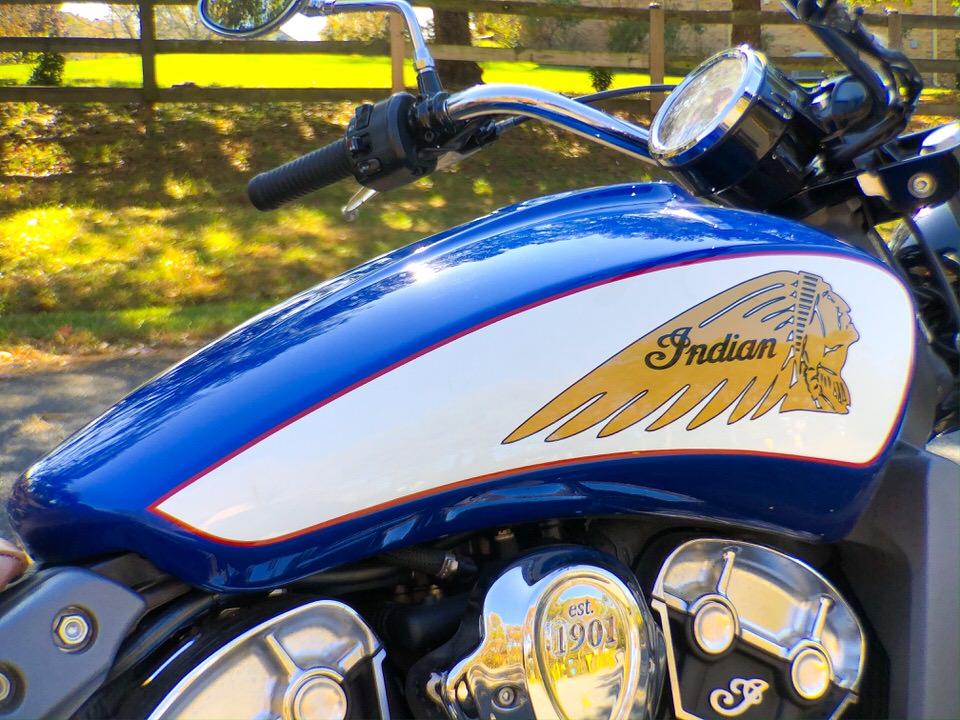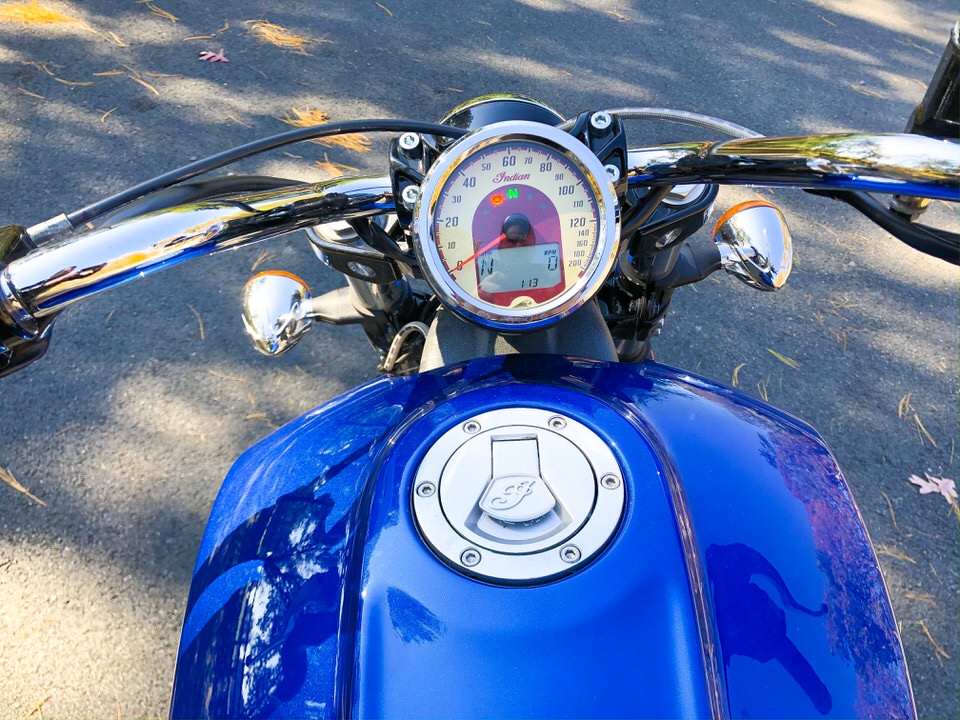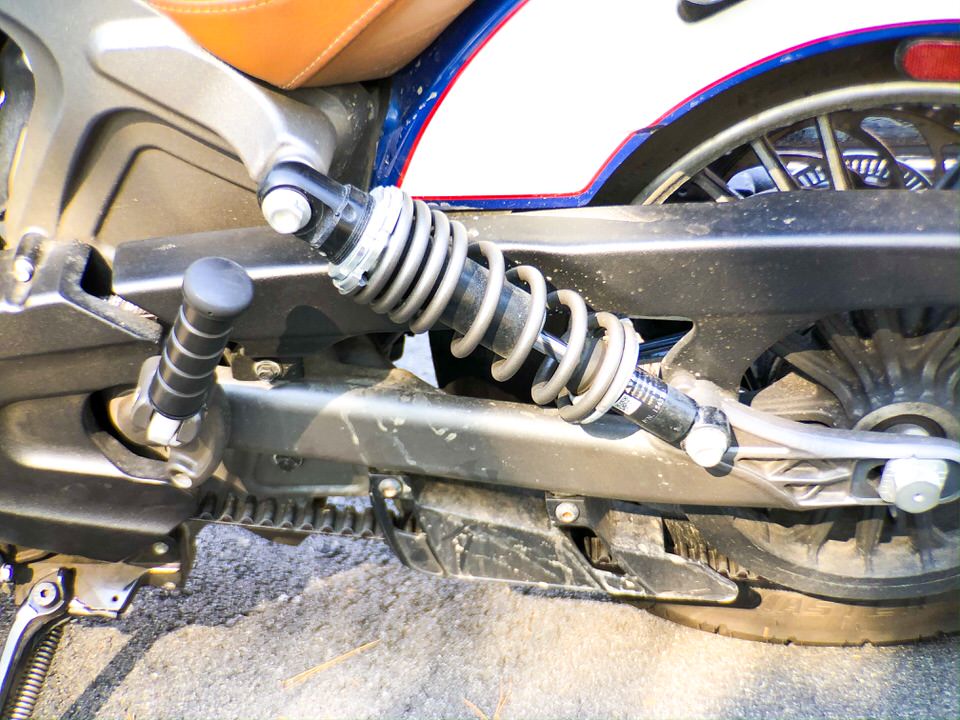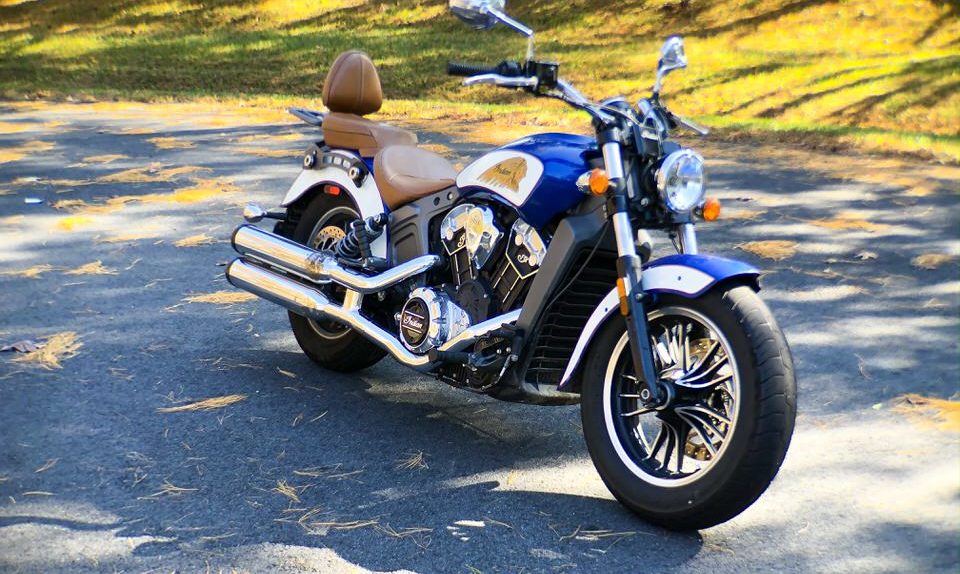The Indian Scout has a long history dating back to 1920 and was reintroduced by the firm in 2015 after Polaris Industries bought the defunct brand in 2011. Originally designed by Charles Franklin, the Scout has always been a very important motorcycle in the company’s range and that is no less true today. Originally produced in Springfield, MA the bikes are currently manufactured in Iowa and engines in Minnesota.

At the heart of the Indian Scout are a combination of great looks and a strong motor attached to a chassis with some dynamism. Whether in color and chrome or in regulation black, the designers got the balance, proportions and details of the Scout right. A long sculpted tank sweeps back from the steering head gracefully, the fenders front and rear arch elegantly around the bike’s sixteen inch tires and rims, and the chrome elements work harmoniously.

The engine is a beauty and sounds authoritative through its two exhaust cannons. The engine is a chassis stress member and the alloy frame components – one integrating the radiator – are stout, nicely finished, and meld well with all of the bright work and chrome. While personal, I thought my review example in blue and white with chrome, looked great in the November autumn sunlight.
At 1131 cubic centimeters or 69 cubic inches, the Scout’s motor produces 100 hp at 8,100 rpm and 72 lb of torque at 5,900 rpm. The engine is potent and energetic for a cruiser and the firm’s engineers need to be congratulated for its tractability and refined characteristics in light of the performance figures higher in the rev range. I found the engine smooth and efficient at low revs – while remaining characterful. At the upper range, between 6,000 and 8,000 rpm, the engine is downright snarly – and a bit buzzy through the bars and pegs.
Belt driven, the Scout’s engine power to the rear wheel is smooth, linear, and without lash or quirks. Working the throttle – acceleration and deceleration – instilled confidence. What my right hand did translated exactly as intended to the rear wheel. Combined with the stout frame, it is easy to see why riders of all skill levels remark on the Scout’s smooth thrust down the road. Even at a spirited pace, the chassis never felt like it was going to tie itself in knots at any point. Moving from stop light to stop light in some medium traffic, the Scout is very well balanced. Even in crawling traffic the engine and transmission are docile. This alone is very confidence inspiring for new riders in urban/suburban environments.

The front brake is a single disk affair of 298mm with a four pot piston, while the rear has the same disk diameter but only a two pot piston. The brakes offer solid performance, with progressive and smooth lever and pedal modulation. My test bike did have ABS, but I did not have an opportunity to test its functionality in battle. The Scout comes with a well spaced 6-speed – the Scout Sixty arrives with a 5-speed – and moving through the gears with the bike’s reasonably smooth clutch was without issue. Occasionally, I found neutral when I did not want it. The pull force required for the clutch is a bit firm in my view – given the bike’s core audience. Standard brake and clutch levers are non-adjustable and should not be at this price point.

The instrument cluster is a simple affair and tastefully presented in red and cream with a small digital section at the bottom. It has all of the essential data readily at hand – speed, gear selection, rpm, and other settings – some available through a lever allowing access to various information. It took about 10 seconds to understand how it all worked. There are no rider modes and there is no need for them here.
The tank holds 3.3 gallons of fuel and over my 200 mile test ride I got 60+ mpg in a mix of riding conditions – perfectly respectable in my view. The seat height is very friendly at under 26 inches, which for shorter folks like myself is welcome. There was never the smallest concern, even on gravel and leaves, that my feet wouldn’t be sure footed. Given the bike’s inherent balance, the machines wet curb weight of about 560 lbs was easy to manage.

The suspension provides three inches of travel out back from its twin shock setup and a little under five inches of travel up front. This setup is easily the bikes weakest link over a variety of surfaces. When the pavement is very smooth the suspension does its job quite well. But when the tarmac is marred or if the rider needs to pass over anything involving something more substantial, the limits become clear. On several instances, the rear suspension blew through its three inch stroke and used my backside and spine for the remainder of its travel needs. This was not welcome. The front forks are better by comparison, but their lack of poise and sophistication is obvious. If I owned a Scout, my first modification would be to upgrade both ends of the bike with quality suspenders. Indian’s accessories catalog and the aftermarket have a number of options available, some quite affordable. This upgrade would be money well spent.

The fine looking leather seat is reasonably comfortable, but I did experience a bit of numbness after approximately 50 miles. A short break to take a few pictures and film solved this problem. The accessories catalog has other options to solve seating challenges. Overall, the rider ergonomics are reasonably comfortable by midsized cruiser standards. It is no commuter, but for Sunday rides to enjoy the scents and sounds of the countryside with no destination in mind, the Scout is a very solid choice.
Primary competition for the Indian Scout comes from Harley Davidson and its Sportster model and some versions of the Softail. The big four Japanese firms have bikes in this space as well. However, for those wanting a motorcycle made here in the United States – it’s an Indian and Harley Davidson showdown.
The Scout comes in two flavors with the smaller engined Scout 60 starting at $8,999 (another $800 with ABS) while the standard version begins at $11,499, with two-toned versions like the one reviewed here starting at $13,299 with ABS. Sales have been strong since the bike’s introduction in 2015, and in my search I only saw a few 2019s available at area dealerships, with some 2020s arriving here in November 2019. Similarly, used Scout’s are available in limited numbers and at price points reflecting strong pricing in the second hand market.

The Indian brand has created a motorcycle with a combination of classic good looks, potent cruiser performance, lovely exhaust note, and approachable ergonomics at a reasonable price point for most models. Combined with an extensive accessories catalog allowing owners to make their bike more comfortable, a better tourer, or project something important to the world, the Scout is a bike that hits high points for lots of people. During my day long review I had any number of people in their cars or passersby take a second or third look at the bike. For many, the Indian Scout is a great looking American motorcycle that visually represents what motorcycling is all about here in the USA.
Happy Riding





